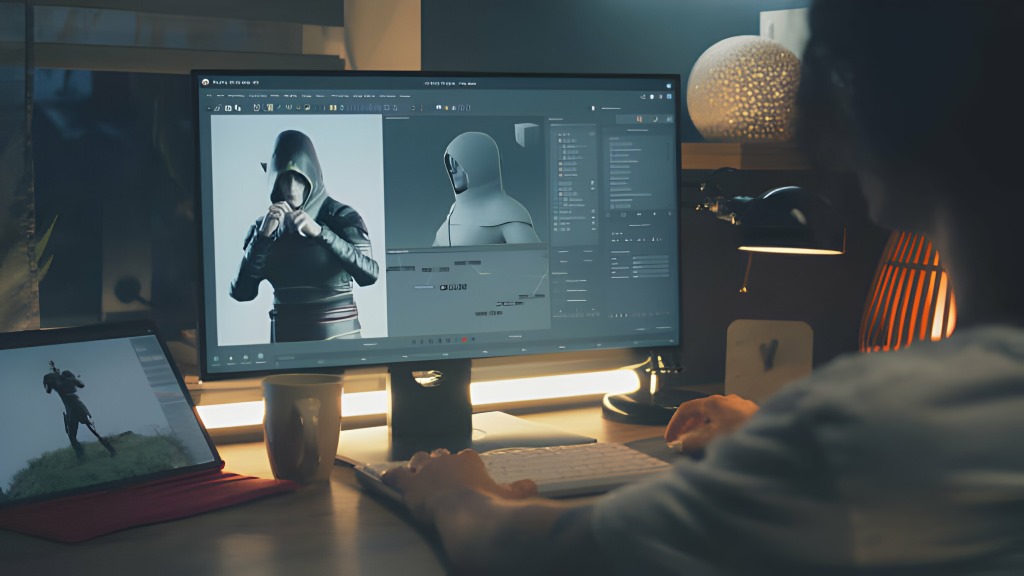In the dynamic world of video gaming, graphic design stands as a cornerstone, breathing life into virtual worlds and characters with its creative prowess. The fusion of artistry and technology in graphic design has not only transformed gaming visuals but has also elevated the overall gaming experience to unprecedented levels of immersion and engagement.
In this exploration of “Playful Pixels,” we’ll delve into the profound impact of graphic design on next-level gaming experiences. From setting the stage with immersive environments to bringing characters to life with captivating designs, graphic design shapes the very essence of modern gaming.
Join us as we uncover the intricate artistry behind gaming’s visual allure and its profound influence on the way players interact with and perceive virtual worlds.
The Role of Graphic Design in Gaming
Graphic design in gaming is more than just creating visually appealing landscapes and characters; it’s about crafting immersive experiences that captivate players and draw them into the game world. Graphic designers in Denver bring creativity, innovation, and technical expertise to the forefront, elevating gaming experiences to new heights.
By seamlessly integrating artistry with technology, graphic design elevates gaming experiences to new levels of immersion and engagement, shaping the way players interact with and perceive virtual worlds.
Setting the Scene: Creating Immersive Environments
One of the most significant contributions of graphic design to gaming is its ability to create immersive environments that draw players into the game world. Through the use of stunning visuals, intricate details, and atmospheric effects, graphic designers craft virtual landscapes that feel vibrant, dynamic, and alive.
Whether exploring a post-apocalyptic wasteland or traversing a fantastical realm, players are transported to alternate realities where every pixel contributes to the overall ambiance and immersion.

Bringing Characters to Life: Designing Memorable Avatars
Graphic design also plays a crucial role in character creation, breathing life into virtual avatars that players control and interact with throughout their gaming routine. From iconic protagonists to memorable villains, character designers use a combination of artistry and storytelling to craft compelling personas that resonate with players on an emotional level.
Through expressive facial animations, fluid movement mechanics, and intricate costume designs, characters become more than just pixels on a screen—they become vessels for player agency, empathy, and connection.
Pushing the Boundaries: Advancements in Graphic Technology
Advancements in graphic technology have revolutionized the gaming industry, pushing the boundaries of visual fidelity and realism to unprecedented heights. From the early days of basic pixel art to today’s high-definition textures and cutting-edge ray-tracing effects, graphic designers continually harness technological innovations to create visually stunning game experiences.
With each new generation of hardware and software, the potential for immersive storytelling and breathtaking visuals expands, promising players increasingly lifelike and immersive worlds to explore and enjoy.
From Pixels to Polygons: Evolution of Visual Fidelity
Over the years, advancements in graphic technology have revolutionized the gaming industry, pushing the boundaries of visual fidelity and realism to unprecedented heights. From the early days of 8-bit sprites to the latest high-definition textures and ray-tracing effects, graphic designers have embraced technological innovations to create visually stunning gaming experiences rival Hollywood blockbusters.
With each new generation of hardware and software, the potential for immersive storytelling and breathtaking visuals continues to expand, paving the way for next-level gaming experiences.
Embracing Artistic Expression Diversity in Visual Styles
While cutting-edge technology has enabled photorealistic graphics, graphic designers also embrace artistic expression and diversity in visual styles to create unique and memorable gaming experiences. From cel-shaded aesthetics to pixel art nostalgia, each visual style offers a distinct aesthetic identity that enhances gameplay immersion and fosters creativity.

By pushing beyond the constraints of realism, graphic designers can experiment with abstraction, symbolism, and surrealism to evoke emotions, provoke thought, and challenge players’ perceptions of reality.
The Intersection of Graphic Design and Gameplay
The intersection of graphic design and gameplay is where the magic truly happens in gaming. Here, visual elements seamlessly merge with interactive mechanics to create immersive and engaging experiences for players.
Graphic designers play a crucial role in enhancing gameplay by designing intuitive user interfaces, dynamic visual cues, and captivating environments that not only look stunning but also facilitate seamless interaction.
Through strategic integration of graphic elements, designers enrich the gaming experience, making every moment in the virtual world more immersive, intuitive, and enjoyable for players.
Seamless Integration: Enhancing Gameplay Mechanics
In addition to shaping the visual aspects of gaming, graphic design also plays a crucial role in elevating gaming engagement. Through intuitive user interfaces, visual cues, and interactive elements, graphic designers facilitate player engagement and immersion, ensuring that the gaming experience remains seamless and enjoyable.
Whether designing intuitive control schemes, dynamic HUD displays, or immersive heads-up displays (HUDs), graphic designers strive to create interfaces that empower players to navigate virtual worlds easily and efficiently.
Storytelling Through Visual Language
Moreover, graphic design serves as a powerful storytelling tool, conveying narrative elements and world-building through visual language. From environmental storytelling to cinematic cutscenes, graphic designers use imagery, typography, and color palettes to evoke mood, convey emotion, and communicate plot points without relying on dialogue or text.
The Future of Graphic Design in Gaming
The future of graphic design in gaming holds boundless potential for innovation and creativity. Emerging technologies like virtual reality (VR), augmented reality (AR), and real-time rendering are poised to revolutionize the way we experience games, offering unprecedented levels of immersion and interactivity.
Graphic designers will play a pivotal role in harnessing these technologies to create truly immersive and unforgettable gaming experiences. From fully immersive VR worlds to interactive AR overlays, the future of graphic design in gaming promises to push the boundaries of creativity and innovation, opening up new possibilities for storytelling, gameplay, and player engagement.
Embracing Innovation VR, AR, and Beyond
As technology continues to evolve, the future of graphic design in gaming holds exciting possibilities for innovation and experimentation. Emerging technologies such as virtual reality (VR), augmented reality (AR), and real-time rendering present new opportunities for graphic designers to push the boundaries of creativity and immersion.
From fully immersive VR worlds to interactive AR experiences, graphic designers are at the forefront of shaping the next generation of gaming experiences that blur the lines between reality and fiction.

Accessibility and Inclusivity: Designing for All Players
Furthermore, graphic designers are increasingly focused on creating gaming experiences that are accessible and inclusive to players of all backgrounds and abilities. By incorporating features such as customizable controls, colorblind modes, and text-to-speech options, designers ensure that everyone can enjoy the magic of gaming regardless of physical or cognitive limitations.
As the gaming community grows and diversifies, graphic designers play a vital role in championing inclusivity and representation in the industry. Sports environments present a unique canvas for graphic design to thrive, blending the excitement of athletic competition with the creativity of visual storytelling.
Conclusion
Graphic design serves as the creative engine that drives next-level gaming experiences, shaping virtual worlds, characters, and narratives with meticulous attention to detail and artistic expression.
From immersive environments and memorable characters to intuitive interfaces and innovative gameplay mechanics, graphic designers play a central role in crafting gaming experiences that captivate, inspire, and entertain players around the world.










